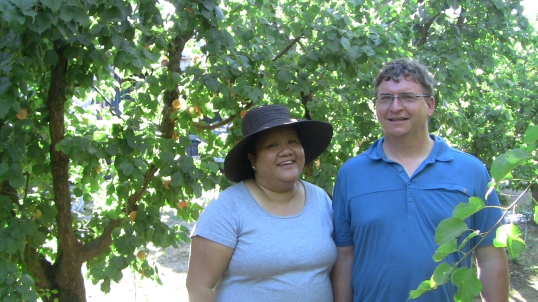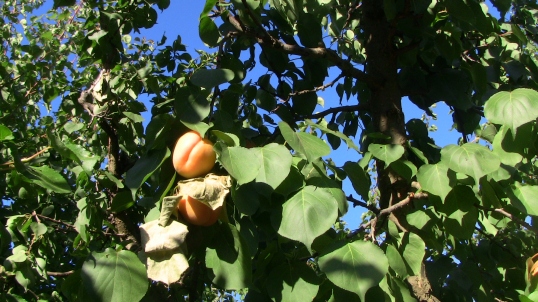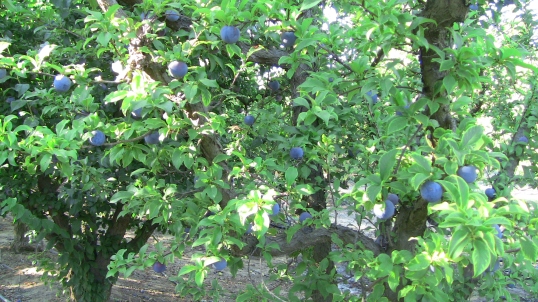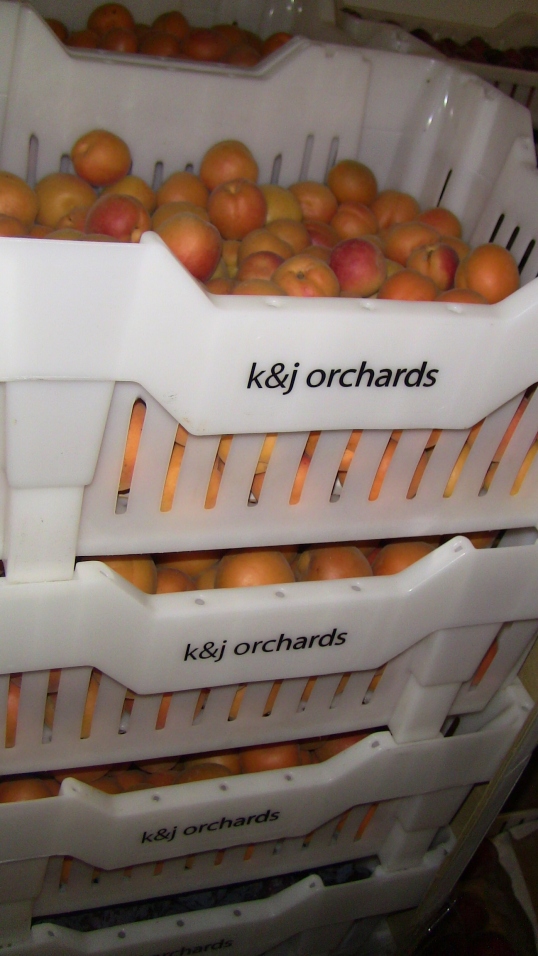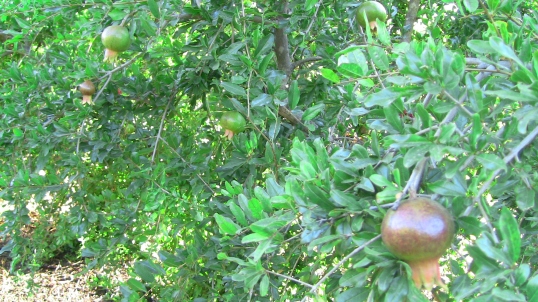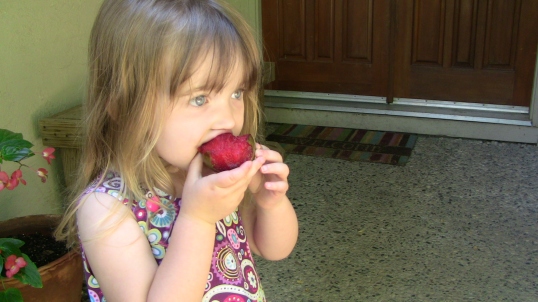Fruit to chef: K&J Orchards
Farmer Tim Deasy met me and my family at the gate of K&J Orchards in Winters, his face dripping with sweat. It was 105 degrees F, and he’d just returned from Napa, where he’d delivered 40 pounds of white peaches to The French Laundry, often regarded as the best restaurant in the United States. He travels about 750 miles a week delivering fresh peaches, plums, pluots, nectarines, cherries and more to restaurants and farmers markets in the Napa-Sonoma region and Bay Area.
There are perks to the job. Sometimes, the chefs he delivers to feed him. “I figured out if you stare at something long enough, they’ll eventually ask, ‘Are you hungry?” said Tim.
In the past 10 years, K&J Orchards has grown from delivering fruit and nuts to three farm-to-table restaurants in San Francisco to upwards of 110 restaurants today. Chefs like Annie Somerville of Greens and other foodies also track K&J down at the Ferry Plaza Farmers Market in San Francisco and other markets in the Bay Area and Northern Nevada.
“We provide access to heirloom varieties or unique things,” said farmer Aomboon (“Booney”) Deasy, Tim’s wife. “Like when chefs ask me for green almonds or green plums to use in salads, or peach leaves to infuse syrups and sauces.”
Booney’s parents, Kalayada Ammatya and James Beutel, are the “K” and “J” of the operation. The couple started the farm in the early 1980s on about 40 acres in Yuba City, which continues to be their main site for growing apples and pears. They bought the 20-acre property in Winters in 1995 and set about converting about half of the then-walnut farm to stone fruit production.
While James, a former pomology professor, has retired from the farm, Kalayada continues to graft rootstock, plant seeds, and do farmers markets. Meanwhile, Booney and Tim have now taken on the primary responsibilities for the orchard.
Defying the heat, or perhaps common sense, my husband, 3-year-old daughter and I walked out to the orchard for a tour.
Strolling among rows of apricot trees, Tim described when he first learned Booney was from a farming family.
“When I first met her in college, I asked her what she did — I thought maybe a coffee shop or something. She said, ‘I sell cherries …'”
“He thought I had a lemonade stand, like selling cherries by the side of the road,” added Booney.
“Yeah, but she left out about 180 other varieties of fruit we now grow,” finished Tim. “But it’s fun.”
As we walked, apricots blushed in the late afternoon sun. Booney plucked one from the tree — a Flaming Gold variety–and handed it to me. Sweet, sun-infused, juicy burst. Later, when we got home, my husband bit into one of those apricots, and the juice squirted all over the counter. “Haven’t seen an apricot do that before,” he said.
In the orchard, cherry trees, now picked clean, were ready to retire for the year. Booney said that while Washington cherries are just beginning, the season for cherries in California will be over by the end of June because yields state-wide are low this year — and prices higher — due to a mild winter. On the upside, the surviving cherries are huge and delicious, not having had to share resources with many other cherries on the tree.
Plenty of other fruit is on its way for the year. Along our tour we saw small green balls of what will become golden meyer lemons hanging from branches, nectarines and peaches preparing for their imminent debut, spiky balls of early chestnuts, and generously spaced plums, their skins a deep purple.
This generous spacing of fruit on the tree is one reason the region’s best chefs seek out K&J Orchard’s fruit. Call it a flavor trick that is mind-blowingly logical: Rather than allow the trees to heave with fruit and compete for water and nutrients, they thin the fruit so the best resources go to those that remain. This, said Booney, results in a bigger, sweeter, better stone fruit.
For every thinned nectarine that never sees a chef’s table or canvas shopping bag, K&J still has plenty to go around. From the scorching 105 degree heat, we stepped into the orchard’s 45 degree refrigerated walk-in. After welcoming the blast of cold air, our eyes set on thousands of pounds of peaches, plums, apriums (a cross between an apricot and a nectarine) and pluots (a cross between a plum and an apricot), all stacked in white trays, ready for distribution.
Booney said it was Tim’s idea to target directly selling to restaurants. With images of chefs with Food Network and Hell’s Kitchen-like personalities, it was a somewhat intimidating prospect at first, she said.
“But all the chefs we work with are so down-to-earth,” said Booney. “They really appreciate the fruit, respect it and where it’s from, and they’re really intrigued to learn how it’s grown.”
At the end of our tour, we passed a row of white pomegranates, which should be ready by late August.
The white pomegranate has pale pinkish seeds inside rather than the deep red of its more famous sibling, is reportedly sweeter and less tart, and won’t stain your fingers.
It’s a tasty twist on a beloved classic and is one example of why Tim shouldn’t expect to reduce his work mileage any time soon.
You don’t have to go to a fancy restaurant to have a taste of K&J Orchard’s fruit. Catch them at farmers markets in San Francisco, Palo Alto, Alemany, Los Gatos, Menlo Park; and at Nevada farmers markets in Reno, Gardnerville and Minden.


